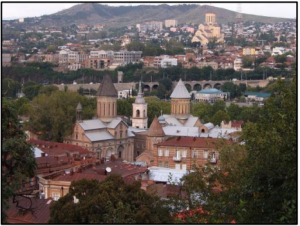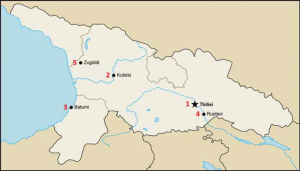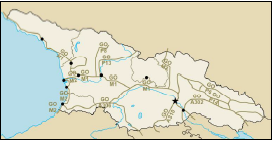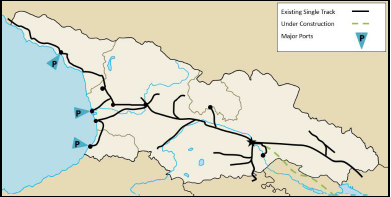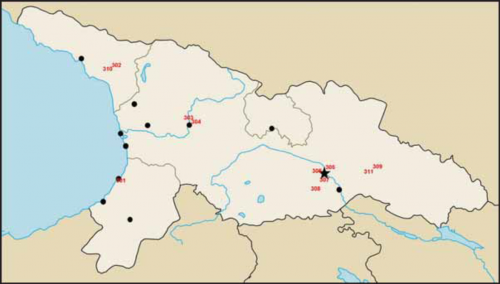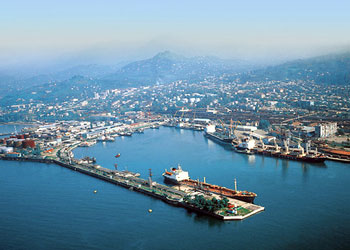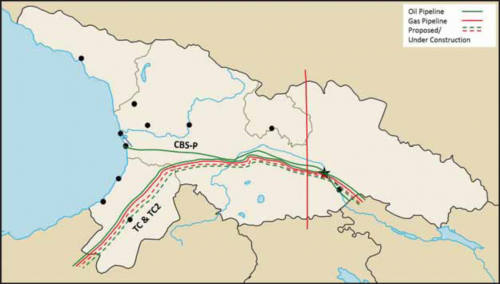Infrastructure: Gorgas
While the region’s five countries have a significant number of rural residents, the majority of each country’s population lives in urban areas. About two-thirds of the Arianian (68%), Donovian (67%), and Limarian populace (64%) and just over half of the Gorgan (53%) and Atropian (52%) populace live in urban areas. All five countries contain a mixture of modern urban cities and almost pre- modern rural villages. Modern utilities can be found in most major cities but not in the rural villages and countryside.
Gorgas contains few natural resources and little industry and needs to find its role in the Caucasus region. This is true for Gorgan infrastructure, as the country possesses a negative urbanization rate of 0.6%. In order for some urban Gorgans to avoid starvation, they returned to their rural roots
where they can attempt to survive through subsistence farming. Most rural Gorgans cannot access modern utilities (electricity, potable running water, and a modern sewage disposal system), and the same holds true for many urban Gorgans. Even with one-third of the Gorgan people located in one city, Gorgas remains almost evenly split between urban and rural dwellers.
As previously mentioned, the majority of residents in all five countries live in urban areas. Most urban cities contain a mixture of old neighborhoods with roughshod construction, while buildings in newer neighborhoods are made with modern construction methods. In rural villages and areas, residents use whatever materials they can obtain to build their houses.
Gorgas’ largest cities contain four distinct types of neighborhoods based on the time of their construction. The oldest parts of the cities contain the dense random construction as the city grew from a village to a metropolitan area. The second area consists of extra-large rectangular block apartment buildings in closed orderly block construction that suffer from a lack of maintenance. The third area consists of neighborhoods that use more Western-style construction methods. In those cities that possess significant industrialization, houses built to support a factory exist to create a strip area neighborhood. For the most part, Gorgas does not possess the financial capacity to maintain its infrastructure, either private or public.
Tbilisi remains the only Gorgan city with enough people where military operations would likely require a significant amount of urban operations. No other city possesses a population of over 200,000 people. Even in these smaller cities, however, military personnel will face dense random construction in the inner cities with narrow alleys and buildings built close to each other. Except for Tbilisi, the lack of an urban population may create manpower shortages for any host nation support requests.
Major Gorgan Cities and Urban Zones
While the majority of Gorgas’ citizens live in urban areas, 47% of its citizens live in rural areas. One- third of Gorgas’ 4.5 million inhabitants live in its capital city, Tbilisi. In fact, no other Gorgan city possesses a population with over 200,000 inhabitants. The lack of any major cities other than Tbilisi could make the distribution of information to citizens difficult, but will also deter any insurgents’ ability to unite their supporters.
Tbilisi
Tbilisi, Gorgas’ capital and largest city at around 1.5 million metropolitan area residents, grew on both sides of the Kura River due to its strategic location on the trade routes between Europe and Asia. It lies over 200 miles east of the Black Sea, surrounded by mountains on three sides. The mountain ridges that extend down from the Trialeti Range of the Lesser Caucasus Mountains to the city mean Tbilisi contains both densely populated low-rise residential neighborhoods and largely uninhabited tracts of land on the south side of the Kura River. This difficult terrain forced Tbilisi to build on the north side of the Kura River to the east and northeast. The oldest city neighborhoods contain buildings that feature Middle Eastern-influenced dense random construction, forming city core and core periphery urban zones. Tbilisi contains the country’s largest industrial area and possesses several thriving commercial areas. The city operates a subway system with two lines, 22 stations, and 186 cars. The Gorgan military places several of its key military units in bases in the Tbilisi metropolitan area.
Kutaisi
Kutaisi, Gorgas’ second-largest city at just under 200,000 people, lies about 138 miles west of Tbilisi and 60 miles east of the Black Sea along both banks of the Rioni River. Due to the physical constraints of the Greater Caucasus Mountains to the north, Kutaisi grew primarily toward the southeast to its current population of 199,780 residents. The city features a large number of parks and abundant greenery attributable to its physical location, climate, and spring snowmelt. Kutaisi contains both city core and core periphery urban zones. While some high-rise residential areas exist, most residents live in low-rise residential urban zones. The city contains the normal number of commercial areas for a city its size, but not many industrial areas.
Military activities in the Kutaisi area will find a dichotomy of urban and rural military operations at the same time. The random construction, while not as dense as many other old cities, will require significant numbers of soldiers to clear. Due to the large number of farms on Kutaisi’s outskirts, military operations should not significantly damage the food transportation network.
Batumi
Batumi, with a population of over 120,000 residents, is Gorgas’ third-largest city and most important Black Sea port. The city also serves as the last stop of the Transcaucasian Railway. Batumi once served as a kerosene pipeline terminus from Baku, Atropia, but became obsolete once the new Caspian & Black Seas petroleum (CBS-P) pipeline began operation 18 years ago. Still, for its size, Batumi contains a large industrial area as the city serves as Gorgas’ primary port for oil exports. Batumi’s other industries include shipbuilding, food processing, and light manufacturing. While the city does not demonstrate the dense random construction of other old cities, it does not resemble planned orderly square blocks either. More people live in low-rise residential areas than high-rise areas.
Any military operations in the local area will need to ensure that the Batumi port continues its operations so Gorgas can export hydrocarbon products to the Western world and import needed supplies from the rest of the world. Military operations in Batumi will not require much urban operations, and the port should provide a logistics hub for any military operations in Gorgas.
Rustavi
Rustavi, Gorgas’ fourth-largest city at under 120,000 people, lies only 15 miles southeast of Tbilisi along the Kura River. Founded before the 4th century BC on a primary trade route, invaders completely destroyed the city in 1265. Primary industries include iron, steel, chemicals, cement, and synthetic fibers. Over 25% of the population left the Rustavi area 14-18 years ago to find work elsewhere. Still, the city currently contains 90 large- and medium-size industrial plants. While Rustavi lacks the normal city core found in most Gorgan cities, it does possess a core periphery urban zone. Most Rustavis live in high-rise residential areas, with some low-rise residential areas on the city’s edges. While commercial areas exist, the exodus of the population created a large number of vacant buildings.
Any military operations in the Rustavi area will likely encounter high levels of pollution. Military units will need to test any water sources before use. The city does not contain much dense random construction. The old rectangular box-style apartment buildings, however, may require room-by- room clearance in any urban operation. Any military activities in the Rustavi area may find a limited amount of manpower and supplies from the host nation, so the military should plan on providing all its own logistics support.
Zugdidi
Zugdidi, with a population of just over 75,000 people, is Gorgas’ fifth-largest city. Due to its nearness to one of Gorgas’ breakaway territories, Zugdidi has doubled its population with the influx of internally displaced persons (IDPs) over the past 19 years. Most construction consists primarily of random construction but not as dense as most city centers. In the Gorgas-Zabzimek war 19 years ago, Zugdidi changed hands several times in the fighting between the two sides. Zugdidi contains a dense city core urban zone with the adjacent core periphery. Most citizens live in low-rise residential urban zones. Few industrial areas exist due to its relatively small size, but commercial areas thrive to support the recent growth in population.
Any military activity in the Zugdidi area may cause additional internally displaced persons (IDPs) as the people may fear possible extermination from the other side as in previous recent wars. Due to the city’s small size, the military should not expect either manpower or supplies from the local area so all logistical support will likely remain organic to the military unit. Military units should expect that the local civilians will want protection from the other side as local combatants may use any excuse to obtain vengeance for past wars. As a result of the dense random construction of much of Zugdidi, military operations could face extensive urban operations in the local area.
Population Density
- Tbilisi: 1,588 people per square mile
- Kutaisi: 7,124 people per square mile
- Batumi: 6,027 people per square mile
- Rustavi: 5,258 people per square mile
- Zugdidi: 3,999 people per square mile
Utilities
The Caucasus area faces a dichotomy when it comes to utilities such as electricity, water, and sewage treatment. Most urban households can access modern utilities, but rural areas cannot. Many rural residents who cannot access modern utilities live similarly to their ancestors generations ago.
Power
Another dichotomy in the Caucasus region is that countries like Ariana, Atropia, and Donovia export hydrocarbons, coal, or electrical power to other countries, while Gorgas and Limaria must import the same resources to meet their requirements. The countries that can export hydrocarbon products or electricity become richer while those that must import significant quantities of power become poorer. At least 75% of all structures in the five countries can access power because they are located in urban areas.
Gorgas contains very little hydrocarbon resources, small coal deposits, and limited electrical generation capacity. What electricity Gorgas produces comes from a limited number of very small hydroelectric plants. Gorgas increased its natural gas and coal imports over the past six years to offset its reduced ability to purchase crude oil. Over the last decade, Gorgas barely managed to obtain enough power to keep its people from freezing in the winter months. Overall, at least 75% of the people in Gorgas can access a modern power system.
Gorgas’ lack of hydrocarbon resources forces it to purchase oil and gas from other countries. Unless Gorgas finds a way to produce more electricity through hydropower, the country will always need to rely on other countries for its energy resources.
Water
The majority of the Caucasus region’s urban population has access to potable water. As areas become more rural, people must rely on local sources—rivers, streams, and wells—to obtain water for cooking, drinking, and washing.
Most residents in Gorgas’ four largest cities—Tbilisi, Kutaisi, Batumi, and Rustavi—can access potable water. Except for Kutaisi, where 96% of the people receive their water from wells, all residents in the other three cities receive drinking water through a modern system. Only 31% of Zugdidi residents, however, can access potable water through a Western-style system. Most rural residents do not have access to a modern water system and still obtain their water through rivers, streams, and wells that remain susceptible to contamination. Since almost half the populace is rural and two of the major cities lack extensive modern systems, only around 50% of the Gorgan people can access a modern water system.
Sanitation
The vast majority of Ariana, Atropia, Donovia, and Gorgas urban residents use modern sewage disposal methods to get rid of waste, but most Limarians do not. Urban residents have greater access to modern sewage treatment than rural residents. The more remote a person, the less likely he/she will use modern sewage treatment techniques. Poor disposal methods in rural areas contaminate ground water that other residents rely on for drinking and cooking.
Overall, only 45% of Gorgas’ cities and towns possess a functional modern sewage system. In Gorgas’ four largest cities, at least 75% of all residents can access a modern sewage disposal system. This ranges from a high of 97% in Tbilisi to a low of 74% in Rustavi, with Kutaisi and Batumi in the 80% range. Gorgas’ fifth largest city, Zugdidi, remains an outlier as only 8% of its residents can access a modern sewage system. The majority of Gorgan rural residents cannot access a modern sewage system either, but the overall access rate for Gorgan people is 60%.
Transportation Architecture
Roads are the primary transportation method throughout the Caucasus region. Train and especially air travel remain too expensive for many residents of Ariana, Atropia, Gorgas, and Limaria. Most roads, especially the unpaved ones, suffer from a lack of maintenance. Ariana and Donovia maintain a complex transportation architectural system while the other three countries operate a moderate one due to railway system limitations.
Road System
Overall, roads in this part of the world do not meet US or Western European standards. Driving is hazardous, especially in the winter months or in bad weather. Generally, drivers do not obey all traffic laws, and vehicle owners often fail to maintain their vehicles properly.
Gorgas contains approximately 12,632 miles of road. About 39% or 4,880 miles of paved roads exist throughout the country. From Tbilisi, four main highways spoke off in the four cardinal directions—north, south, east, and west—to Donovia, Limaria, Atropia, and the Black Sea. Gorgas labels its three best highways M1, M2, and M3. Highway M1 (M27) goes west from Tbilisi to Kutaisi and then to Senaki, where it turns north to the Gorgan border. Highway M2 (A305) parallels the coastline through Batumi, and Poti, both Black Sea ports, before it turns northeast to Senaki. M3 starts in Tbilisi and goes almost due north into Donovia. Most rural Gorgan roads do not receive proper maintenance, and rain further deteriorates the road system.Bus
All five countries maintain some sort of bus system, but its quality depends on the country and location. The larger the city, the more likely it will operate a public bus system. Usually, intercity buses run between the larger cities, and “private” buses may also operate in some areas. Due to the relatively cheap cost of public transportation, buses remain a favorite method for local civilians to travel long distances within their country.
Both official and unofficial buses operate in Gorgas. Intercity bus service operates between Tbilisi and other larger Gorgan cities such as Batumi and Kutaisi. Buses also operate on routes from Tbilisi to cities in Atropia. Currently, no buses operate between Tbilisi and Donovia.
Rail
All five Caucasus countries operate a railroad system, but they suffer many problems due to maintenance issues, non-standard equipment, criminal activity, and high cost.
Gorgas contains 1,002 miles of railway track throughout the country that link it with Donovia, Atropia, and Limaria. The Gorgan railroad suffers from poor maintenance, criminal activity, and fuel shortages that make it unreliable.
Tbilisi operates a subway system that covers just over 16 miles in the Gorgan capital city. Twenty below-ground and two above-ground stations service over 105 million passengers annually. The Tbilisi subway operates between 0600 and 2400 daily.
Air Transportation Systems
All five countries maintain both paved and unpaved runways of varying distances. Many of the unpaved runways resemble nothing more than a cleared dirt path only suitable for the sturdiest of planes.
Gorgas contains 18 paved and 4 unpaved runways for a total of 22 runways in the entire country. All unpaved runways in Gorgas do not exceed 5,000 feet. The map on the following page indicates the location of the major Gorgan runways, and the chart provides the data on each runway (not all runways shown on map or chart).
Paved Runways
- Over 10,000 feet: 1
- 8,000 to 10,000 feet: 7
- 5,000 to 8,000 feet: 4
- 3,000 to 5,000 feet: 4
- Under 3,000 feet: 2
Unpaved Runways
- Over 10,000 feet: 0
- 8,000 to 10,000 feet: 0
- 5,000 to 8,000 feet: 0
- 3,000 to 5,000 feet: 2
- Under 3,000 feet: 2
Major Runways
| Map # | Elevation (Feet) | Latitude (D, M, S) | Longitude (D, M, S) | Length (Feet) | Width (Feet) | Surface Type |
| 301 | 105 | 41 36 37.00 N | 41 35 58.90 E | 7325 | 150 | Asphalt |
| 302 | 79 | 43 06 14.56 N | 40 34 45.38 E | 9802 | 164 | Concrete |
| 303 | 223 | 42 10 36.57 N | 42 28 57.77 E | 8202 | 144 | Concrete |
| 304 | 384 | 42 14 55.01 N | 42 37 28.78 E | 4692 | 114 | Asphalt |
| 305-1 | 1624 | 41 40 09.00 N | 44 57 17.00 E | 9843 | 147 | Concrete |
| 305-1 | 1624 | 41 40 09.00 N | 44 57 17.00 E | 8202 | 196 | Asphalt |
| 306 | 1305 | 41 27 33.16 N | 44 46 59.56 E | 8170 | 130 | Concrete |
| 307 | 1250 | 41 38 57.24 N | 44 56 11.15 E | 8131 | 255 | Concrete |
| 308 | 1460 | 41 37 40.95 N | 45 01 50.70 E | 8205 | 175 | Concrete |
| 309 | 1795 | 41 22 46.36 N | 46 22 02.40 E | 8862 | 130 | Concrete |
| 310 | 53 | 42 51 29.64 N | 41 07 41.32 E | 12012 | 172 | Concrete |
| 311 | 1489 | 41 57 12.35 N | 45 30 28.78 E | 5551 | 110 | Asphalt |
Airports/Airlines
Gorgan Airlines operates as the country’s national carrier. Gorgan Airlines provides direct service domestically to Batumi and internationally to 12 European and Asian countries. Gorgas Airlines operates daily flights to some cities, but only once or twice per week to others. Several foreign carriers such as Lufthansa and British Airlines operate flights into Tbilisi. Tbilisi power outages sometimes strike the airport and force pilots to land without electronic airport navigation aids. Gorgan Airlines operates Canadian Regional Jet (CRJ)-100, CRJ-200, and Boeing 737 airplanes. The American Embassy advises travelers to use Western carriers to avoid the risk from poorer maintenance procedures by non-Western airlines.
Maritime Seaports
Gorgas has 3 seaports located along the Black Sea. There are 2 Gorgas ports that average more than 1 million tons of cargo throughput annually. There are no ports that can accommodate Military Sea Lift (MSC) Commands Large, Medium-Speed Roll-on/Roll-off (LMSR). Gorgas largest and most productive port is the Port of Batumi, which is the capital of Gorgas, just 15 kilometers north of the border with Turkey on the southeast coast of the Black Sea. Batumi port operates year-round and serves as the primary port to handle oil exports and imports that range from four to 15 million tons annually. The Port of Batumi is the main industry is an oil refinery that processes petroleum from Baku. It also contains a shipyard and industries that manufacture machines and furniture.
In addition to being a busy industrial city, the Port of Batumi is a popular resort and a pretty city. It has beautiful gardens and streets, and it is home to a popular nearby Botanical Garden. It is in the center of a citrus- and tea-growing area, with tea plantations at the city’s borders. About 138 thousand people call Batumi home. The Port of Poti, located at the end of the Rioni River, contains 17 berths that include some floating cranes. With its current storage facilities, both warehouse and open space, the port can handle 8 million tons of imports and exports annually. Sokhumi port, located on the bay of the same name, contains one cargo pier and two passenger quays. Due to damage from Gorgas’ wars with Zabzimek, the port is currently operating below full capacity. Gorgas also contains several navigable rivers that the country uses for the transportation of goods. Luckily, the two major rivers—the Kura and the Rioni—flow in opposite directions. The Kura River flows from the southern border eastward to the Caspian Sea. The Rioni River flows west, and the water eventually reaches the Black Sea. While the Gorgans use their rivers for transportation, they primarily use them to generate electrical power. The majority of commercial shipping occurs on the Black Sea and not inland (see railroad map on page 590 for locations of major Gorgan ports).Any military operations in Gorgas could possibly use the three major ports to support the deployment logistically. Sokhumi port, however, would require some additional rehabilitation before it reached full capacity for use by the military.
.
.
.
.
.
.
.
.
Pipelines
The security of hydrocarbon pipelines will be paramount in any military operations in the Caucasus region. Any disruption to the flow of crude oil and natural gas to the Western world could cause economic problems, as many modern countries rely on hydrocarbons to fuel their industries.
Sections of the Trans-Caucasus petroleum (TC-P) and the Caspian & Black Seas petroleum (CBS-P) pipelines pass through Gorgas on their way to ports where the crude oil flows into tankers for refinement in other countries. Gorgas serves as an intermediate country for 220 miles of the 1,099-mile TC-P pipeline that originates in Atropia. The CBS-P pipeline travels basically the same route as the TC-P pipeline through central Gorgas, but the former continues west toward its terminus in Supsa, near Batumi, while the latter veers south. The natural gas pipeline in Gorgas is the Trans-Caucasus natural gas (TC-G) pipeline, which follows the same path as the TC-P pipeline. An additional natural gas pipeline from Limaria to Donovia also crosses Gorgan territory, from which Gorgas receives 10% of its gas as a transit fee. Any military activity in Gorgas will need to mitigate possible damage to these four major pipelines, as the disruptions would hurt the economic systems of both regional and Western countries.
European consortiums are building two additional pipelines to access the fields in Central Asia. These new oil and gas pipelines will originate in Central Asia, cross the Caspian Sea, and then follow the TC-P and TC-G pipelines through Atropia and Gorgas en route to European markets. Referred to as the Trans-Caucasus 2 petroleum (TC2-P) and natural gas (TC2-G) pipelines, they will double the capacity of the current pipelines.
Telecommunications Architecture
For the most part, Caucasus-region residents use cellular telephones to communicate with each other due to the lack of landline telephone infrastructure. Many residents never owned any type of telephone until they received their first cellular phone. Most can access news from either television or radio, but some rural residents have no information access via modern methods. (See Information variable for additional details.)
Similar to other countries in the Caucasus, most Gorgan citizens can use telephone or receive information from a television or radio station. In a country of 4.6 million people, only 618,000 landlines exist but there are over 2.7 million cell phones. Since a long waiting list exists for connection to the fixed lines, most Gorgans turn to the cell phone for their communication needs. In urban areas, about 20% of the people can access a landline, but only about 4% in rural areas. Across the entire country, 75% of all Gorgans can access a cellular telephone. Around one-quarter of Gorgas’ population or over 1.3 million residents can access the Internet from one of the 104,243 Internet hosts. Gorgas operates one state-owned television station with two networks. Eight private television stations also operate along with a dozen cable operators. Gorgas also operates two national and three regional radio stations alongside many private stations. The military will find the radio and television are excellent methods to communicate with most of the Gorgan people.
Industry
Because of their hydrocarbon resources, Ariana, Atropia, and Donovia are more industrialized than Gorgas and Limaria. Industry GDP ranges from a low of 27.1% in Gorgas to a high of 61.4% in Atropia. The protection of the Gorgan hydrocarbon infrastructure remains paramount for any military operations in the area and the military should refrain from any unnecessary damage to the industrial sector to facilitate economic recovery after the end of hostilities.
During the past 11 years, Gorgas has chosen to change the way it does business to improve its economy, moving up from 112th to 18th ranking in the world for ease of doing business. The country, however, still suffers from the residue of Donovian influence in its industrial sector. Prior to the Four Traitors incident two decades ago, 90% of the raw materials for Gorgan light industry came from outside the country, and Gorgas cannot operate without these raw materials. Major Gorgan products include machine tools, prefabricated buildings, cast iron, steel pipe, synthetic ammonia, and silk thread. Gorgas also possesses some gasoline and diesel fuel plants that use imported crude oil. Large amounts of toxic industrial chemicals (TIC) exist throughout Gorgas that are used for multiple purposes, including water purification, wastewater management, and fertilizer to increase agricultural output.
Agriculture
Agriculture production still dominates the labor forces of Gorgas (55.6%) and Limaria (46.2%), but not Ariana (25%), Atropia (38.3%), or Donovia (20%). Even in the Caucasus region’s predominately agricultural countries, farming creates less than one-fourth of each country’s Gross Domestic Product (GDP). Except for Atropia, the region relies on food imports to feed its people. Any food import disruption may increase the military’s burden to feed civilians and prevent starvation.
Of the five countries in the region, more Gorgans work in agriculture-related jobs than any other, at 55.6% of the population. During the past 19 years, the number of Gorgans who work in agriculture has more than doubled from 25%. Even with this large number of farm workers, agriculture only generates 11% of Gorgas’ GDP. Family-operated farms dominate Gorgas as the average farm contains less than 2.5 acres, and only 4.6% of the farms contain more than 5 acres. Only 12% of Gorgas’ land is arable (cultivated), with over 85% of its croplands dedicated to grain production. Corn accounts for 40% and winter wheat for 37% of the cultivated grains produced. Gorgas’ main crops include corn, winter wheat, grapes, tea, citrus fruits, and non-citrus fruits. Gorgans also maintain cattle, pigs, and sheep that account for about 25% of their agricultural economy.
Pollution
All five Caucasus-region countries face significant pollution problems stemming from poor industrial practices. The governments cared more about natural resource extraction and industrial production than the stewardship of the planet. This lack of concern for the environment occurred regardless of which government was in power. The region’s military operations will need to address pollution, with soldiers taking precautions due to high-level air pollution and units considering any local water source not potable until tested.
Gorgas suffers from significant levels of air and water pollution throughout the entire country. Of the cities in the country, Tbilisi, Kutaisi, and Rustavi rank at the top of the list as most polluted. Despite the drop in industrial output 19 years ago, pollution remains rampant. Most air pollution comes from vehicles, industries, and energy production centers. Almost all Gorgan rivers contain excessive pollution, with high concentrations of phenols, hydrocarbons, copper, manganese, zinc, and nitrogen. Most water treatment plants do not work properly or operate on the low end of the efficiency scale. Experts consider at least 60% of Gorgan sewage treatment plants obsolete and in need of immediate replacement. Only 18% of Gorgas’ wastewater receives adequate sewage treatment, and the remainder pollutes its final destination, the Black Sea. The Black Sea pollution, in turn, harms Gorgas’ tourism industry. While the Gorgan government may have attempted to address pollution problems over the last 20 years, results do not show any significant improvements. Gorgas, however, does possess a dedicated Environmental Response Store in case of a spill from the CBS-P pipeline.
Summary
Most of Gorgas contains outdated infrastructure that suffers from a combination of age, outdated technology, lack of maintenance, and damage from conflicts. Due to a lack of funds over the past 25 years, Gorgas never invested much in any type of infrastructure. Lack of financial resources meant that the Gorgan people made shoddy repairs to old equipment if factories possessed the raw materials to continue their production lines. Gorgan infrastructure also suffered collateral damage from combat as parts of the country attempted to break off and form their own independent states. While some improvement occurred over the last decade, the lack of any sizeable capital prevents the modernization of Gorgan infrastructure.

